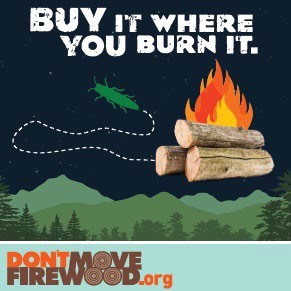
Don’t Move Firewood, The Nature Conservancy
October is Firewood Month! Help prevent the spread of invasive insects and diseases by buying firewood where you burn it.
Firewood Scout can help you find local firewood for sale.
See the DNR website for more information on invasive species and forest health.
The following information is from The Nature Conservancy:
Why is moving firewood a problem?
Tree-killing insects and diseases can hitchhike in firewood. These insects and diseases can’t move far on their own, but when people move firewood, they can be transported hundreds of miles. New infestations destroy forests and property values and can be very costly to control.
How far is too far to move firewood? And what exactly is “local” firewood?
As a general rule of thumb, 50 miles is too far to move firewood, and 10 miles or less is best. When we say local firewood, we are referring to the closest convenient source of wood that you can find. That might be from down the street or cut in a state forest within your county. In many states, there are rules, regulations and quarantines that clearly state how far is too far. Always acquaint yourself with local rules and regulations when transporting wood from one jurisdiction to another. Visit the map at www.DontMoveFirewood.org/map to help determine how far is too far in your area.
My firewood has no bugs, holes, burrows or sawdust on it. Is it okay to transport it?
Even the experts can’t always see a couple of pin-head-sized insect eggs or a few microscopic fungus pores in a pile of wood. These tiny threats are enough to destroy an entire ecosystem. Never assume wood that “looks safe” is okay to move. It is next to impossible for anyone to inspect firewood that closely.
What kind of firewood is safe to move over long distances?
Generally, two types of firewood are safe to move. The first is packaged, heat-treated firewood with a USDA APHIS compliance seal. The other is packaged, heat-treated firewood with a specific state inspection seal. Firewood labeled “kiln-dried” is quite different and should not be considered safe to move.
If I burn my wood completely, is it okay to bring it from far away?
While this might seem reasonable at first, the answer is still no. There are simply too many unknowns. What if a little chip of bark falls unnoticed on the forest floor and that chip contains invasive insect larvae? Or what if a sudden rainstorm washes fungus spores off the wood, out of your pickup truck and into the grass? Even if you intend to burn the wood completely, you still need to ensure it is locally sourced or packaged, heat-treated firewood. You should not be moving untreated firewood long distances, and it is often illegal to do so.
Can I cut wood from my backyard and take it camping if there are no quarantines or past alerts in my area?
This is not a good idea. Pest infestations can take years to be recognized by the authorities. Sometimes, trees appear perfectly healthy for years despite harboring harmful organisms. By the time the tree looks unhealthy, or the quarantine is announced, you could have spread a tree-killing infestation to all your favorite campsites.
Why are non-native insects and diseases so much worse for trees than native forest pests?
Native trees have defenses against native insects and diseases that they’ve been living with for millions of years. Likewise, native predators eat native insects, which keeps their numbers in check, too. Non-native forest insects and diseases have no natural defenses against them and little to no predators and parasites in their new homes. Taken together, that means the non-native insects and diseases can reproduce really fast and become out of control, killing millions of trees in their wake.
